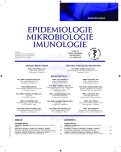Toxic shock syndrome
Authors:
T. Tyll 1; M. Bílková 1; A. Revinová 1; M. Müller 1
; M. Čurdová 2; M. Zlámal 3; M. Holub 3
Authors‘ workplace:
Klinika anesteziologie, resuscitace a intenzivní medicíny, 1. LF UK a Ústřední vojenská nemocnice – Vojenská fakultní nemocnice Praha
1; Oddělení klinické mikrobiologie, Ústřední vojenská nemocnice – Vojenská fakultní nemocnice Praha
2; Klinika infekčních nemocí, 1. LF UK a Ústřední vojenská nemocnice – Vojenská fakultní nemocnice Praha
3
Published in:
Epidemiol. Mikrobiol. Imunol. 64, 2015, č. 4, s. 210-220
Category:
Review Article
Overview
The authors present an up-to-date review of toxic shock syndrome (TSS) – a life-threatening condition where toxins of the Gram-positive bacteria Staphyloccocus aureus and Streptococcus pyogenes play a key role in the pathogenesis. The authors provide insight into the epidemiology and pathogenesis of the disease and point out the relevant patient history data and clinical signs and symptoms that may indicate progression of TSS. Last but not least, the state of the art diagnostic and therapeutic approaches to early and full blown TSS are summarized. Case reports are presented to illustrate two different etiological forms of this relatively rare nosological entity.
Keywords:
toxic shock syndrome – toxigenic strain – toxin – superantigen
Sources
1. Ramesh V, Sat S. Toxic Shock Syndrome [online]. 2015-06-06 [cit. 2015-07-14]. Dostupný na www: http://emedicine.medscape.com/article/169177-overview.
2. Todd J, Fishaut M, Kapral F, Welch T. Toxic-shock syndrome associated with phage-group-I Staphylococci. Lancet Lond Engl, 1978;2(8100):1116–1118.
3. Táborská J. Syndrom toxického šoku. Interní Med, 2009;11(9):405–409.
4. Issa NC, Thompson RL. Staphylococcal toxic shock syndrome. Suspicion and prevention are keys to control. Postgrad Med, 2001;110(4):55–56, 59–62.
5. Beneš J, Petráš P, Kabelková M. Syndrom toxického šoku: souborná práce a kazuistika. Klin Mikrobiol Inf Lék, 1998;4(4):120–125.
6. Cone LA, Woodard DR, Schlievert PM, Tomory GS. Clinical and Bacteriologic Observations of a Toxic Shock-like Syndrome Due to Streptococcus pyogenes. N Engl J Med, 1987;317(3):146–149.
7. Infekce v České republice – EPIDAT [online]. 2015 [cit. 2015-06-25].
Dostupné na www: http://www.szu.cz/publikace/data/infekce-v-cr.
8. Petráš P, Machová I, Ryšková L, Prášil P. Případy menstruální formy syndromu toxického šoku v České republice v letech 1997–2011. Epidemiol Mikrobiol Imunol, 2011;60(4):161–166.
9. Pajerek J, Přibíková R, Petráš P. Syndrom toxického šoku. Pediatr Prax, 2006;7(6):324–326.
10. Que Y, Moreillon PH. Staphylococcus aureus (including staphylococcal toxic shock). In: Mandell, Douglas, and Bennett’s Principles and Practice of Infectious Diseases. Philadelphia: Elsevier Churchill Livingstone; 2009 : 2543–2578.
11. Jacobson JA, Kasworm EM. Toxic shock syndrome after nasal surgery.: Case reports and analysis of risk factors. Arch Otolaryngol Head Neck Surg, 1986;112(3):329–332.
12. Holub M, Arientová S, Jilich D, Davidová A, Beran O, Rozsypal H. Toxic shock syndrome and persistent immune activation in an HIV-positive patient. Curr HIV Res, 2013;11(4):321–325.
13. Bonventre PF, Linnemann C, Weckbach LS, et al. Antibody responses to toxic-shock-syndrome (TSS) toxin by patients with TSS and by healthy staphylococcal carriers. J Infect Dis, 1984;150(5):662–666.
14. Current and Historical Conditions | NNDSS [online]. 2015-05-06 [cit. 2015-06-25]. Dostupné na www: http://wwwn.cdc.gov/nndss/conditions.
15. Levy MM, Fink MP, Marshall JC, et al. 2001 SCCM/ESICM/ACCP/ATS/SIS International Sepsis Definitions Conference. Crit Care Med, 2003(4);31 : 1250–1256.
16. Petráš P. Dva případy stafylokokového syndromu septického šoku. 2. Původní diagnóza appendicitida. Zprávy Cent Epidemiol Mikrobiol, 2004;13(2):76.
17. Petráš P, Džupová O, Beneš J. Dva případy stafylokokového syndromu septického šoku. 1. Původní diagnóza meningitida. Zprávy Cent Epidemiol Mikrobiol, 2004;13(1):24–25.
18. Perry SJ, Reid RD. Toxic Shock Syndrome and Streptococcal Toxic Shock Syndrome. In: Tintinalli JE. Tintinalli´s Emergency Medicine: A Comprehensive Study Guide. 7th ed. McGraw-Hill;2010 : 999–1002.
19. Low DE. Toxic Shock Syndrome. Crit Care Clin, 2013;29(3):651–675.
20. Jindrák V, Chmelík V, Nyč O. Syndrom toxického šoku. In: Jindrák V, Hedlová D, Urbášková P, et al. Antibiotická politika a prevence infekcí v nemocnici. Praha: Mladá fronta a.s.; 2014 : 228–230.
21. Kalyan S, Chow AW. Staphylococcal toxic shock syndrome toxin-1 induces the translocation and secretion of high mobility group-1 protein from both activated T cells and monocytes. Mediators Inflamm, 2008;2008 : 512196.
22. Burnham JP, Kollef MH. Understanding toxic shock syndrome. Intensive Care Med [online]. 2015-05-14 [cit. 2015-07-14]. Dostupné na www: http://icmjournal.esicm.org/index.html.
23. Urbášková P. Někteří významní původci bakteriálních infekcí a pozice antibiotik. In: Jindrák V, Hedlová D, Urbášková P, et al. Antibiotická politika a prevence infekcí v nemocnici. Praha: Mladá fronta a.s.;2014 : 158–186.
24. Stevens DL, Ma Y, Salmi DB, et al. Impact of antibiotics on expression of virulence-associated exotoxin genes in methicillin-sensitive and methicillin-resistant Staphylococcus aureus. J Infect Dis, 2007;195(2):202–211.
25. Ohlsen K, Ziebuhr W, Koller KP, et al. Effects of subinhibitory concentrations of antibiotics on alpha-toxin (hla) gene expression of methicillin-sensitive and methicillin-resistant Staphylococcus aureus isolates. Antimicrob Agents Chemother, 1998;42(11):2817–2823.
26. Dellinger RP, Levy MM, Rhodes A, et al. Surviving sepsis campaign: international guidelines for management of severe sepsis and septic shock: 2012. Critical Care Med, 2013;41(2):580–637.
27. Kaul R, McGeer A, Norrby-Teglund A, et al. Intravenous immunoglobulin therapy for streptococcal toxic shock syndrome – a comparative observational study. The Canadian Streptococcal Study Group. Clin Infect Dis, 1999;28(4):800–807.
28. Raithath AH, Bryden, DC. Use of intravenous immunoglobulin therapy in the treatment of septic shock, in particular severe invasive group A streptococcal disease. Indian J Crit Care Med, 2012;16(1):37–40.
29. Darenberg J, Soderquist B, Normark BH, Norrby-Teglund A. Differences in potency of intravenous polyspecific imunoglobulin G against streptococcal and staphylococcal superantigens: implications for therapy of toxic shock syndrome. Clin Infect Dis, 2004;38(6):836–842.
30. Karauzum H, Chen G, Abaandou L, et al. Synthetic human monoclonal antibodies toward staphylococcal enterotoxin B (SEB) protective against toxic shock syndrome. J Biol Chem, 2012;287(30):25203–25215.
31. Holub M. Novinky u sepse – zpráva z 23. kongresu klinické mikrobiologie a infekčního lékařství. Klin Mikrobiol Inf Lék, 2013;19(2):74–75.
Labels
Hygiene and epidemiology Medical virology Clinical microbiologyArticle was published in
Epidemiology, Microbiology, Immunology

2015 Issue 4
Most read in this issue
- Benign acute childhood myositis as a complication of influenza B and its differential diagnosis
- Human hantavirus diseases – still neglected zoonoses?
- Toxic shock syndrome
- The role of Streptococcus mutans in the oral biofilm
